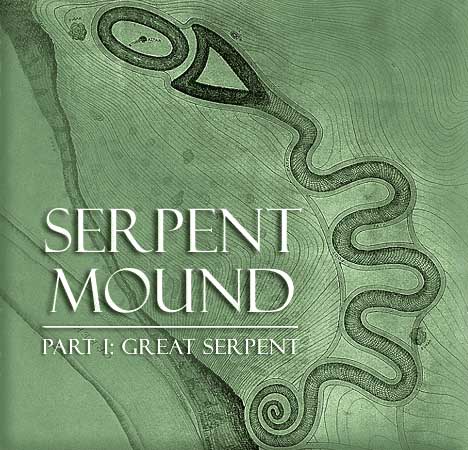
Editorial
|
Press Releases
|
Book Reviews
|
Fragments
Serpent Mound I
|
Giants I
|
Osiria I
Register
for our new Hall of Records Newsletter!
Questions? Comments? Suggestions? Advertising? Press Releases?
Contact us!
Serpent Mound Part II: Sacred Serpent
The Domain of the Serpent
|
The Lair of the Serpent
|
Visiting the Serpent
Serpent Mound Links
|
Serpent Mound Books
|
Serpent Mound Audio
 riving through the rolling countryside of southern Ohio, one can understand why our ancient predecessors in this American continent chose the serpent to symbolize the immanent power of the land. Passing east through the foothills of the Appalachians in southern Ohio, a turn to the north — into the domain of the serpent — quickly brings the adventurer through wave after wave of fertile, rolling hills that seem to brim with numinous power. This is old farm country, Amish country, a place of faith both ancient and modern. This is rural
Ohio.
riving through the rolling countryside of southern Ohio, one can understand why our ancient predecessors in this American continent chose the serpent to symbolize the immanent power of the land. Passing east through the foothills of the Appalachians in southern Ohio, a turn to the north — into the domain of the serpent — quickly brings the adventurer through wave after wave of fertile, rolling hills that seem to brim with numinous power. This is old farm country, Amish country, a place of faith both ancient and modern. This is rural
Ohio.

Located in southwest Ohio
in
Adams County,
near the small farm town of
Peebles,
the Great Serpent Mound has long been considered one of the most famous and enigmatic archaeological remnants of the ancient world. Though
other serpent mounds can be found as far afield as ancient Britain and Mexico, Ohio's serpent mound is by far the largest and most
interesting serpentine effigy mound in the world. Moreover, though the Serpent Mound acropolis is not as extensive as Iowa's
Effigy Mounds, taken as a single mound
it far exceeds even the massive
Great Bear Mound
in both size and sheer spectacle, making it the largest animal effigy mound in the world.
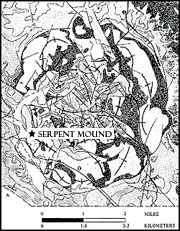
|
|
|
The bedrock geology of the Serpent Mound cryptoexplosion structure, which created a ring-shaped area of raised rock nearly 4 miles
in diameter. Serpent Mound sits on a promontory on the southwest quadrant of this structure. Image adapted from
Serpent Mound Mysteries.
|
|
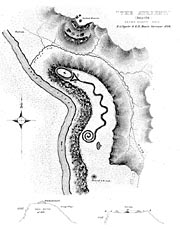
|
|
|
The promontory cliff on which Serpent Mound resides, on the southwest quadrant of the cryptoexplosion structure. This rendering of the
serpent mound acropolis is from Squier and Davis' classic survey of Native American mound structures,
Ancient Monuments of the Mississippi Valley, originally published in 1848. It is slightly inaccurate in that it places the
serpent's head and tail too close to the cliff face, whereas in reality there are several more yards to spare.
|
|
The lush, green, rolling hills of southern Ohio are the perfect location for Serpent Mound. Writhing sinuously though a clearing of trees, it sits upon another mystery of America's ancient past — a unique
"cryptoexplosion structure"
that in ancient times had raised up the high cliffs upon which the serpent now lies recumbent.
The force that caused this massive upwelling of rock has been the subject of several theories — including a
meteoric impact,
a series of gas explosions originating from deep within Earth's interior, and even volcanic and tectonic activity — and remains a source of speculation to this day.
And the unusual structure upon which the Serpent Mound sits is only one of many mysterious anomalies of this region. William F. Romain in his excellent article,
"Terrestrial Observations of the Serpent Mound",
points out many other aspects of this area that make the domain of the serpent truly unique:
 Serpent Mound Lies at the Center of Three Major Physiographic Regions:
Serpent Mound Lies at the Center of Three Major Physiographic Regions:
The Serpent Mound acropolis is located in a 7-8 mile wide peninsula of unglaciated Lexington Plain, also known as "Ohio Bluegrass", that intrudes between unglaciated Appalachian plateau on the east, and glaciated "Till Plain" on the west. In layman's terms, Serpent Mound was strategically placed to command a view of the foothills of the Appalachian mountains to the east, and the open, fertile plains in the west.
 Serpent Mound Lies at the Locus of Three Distinct Forest Types:
Serpent Mound Lies at the Locus of Three Distinct Forest Types:
The Serpent Mound acropolis also sits in a narrow region of
"Mixed Mesophytic"
forest, bordered by Oak, Sugar Maple and Beech forests. Mixed Mesophytic forests are a remnant of the type of forest that once covered North America in ancient times. They are made up a wide variety of trees and plantlife including primarily Sugar Maple, Buckeye, Basswood and Red Oak, as well as Big-Leaf Magnolia, American Beech, Blackgum, and Euomymus. The soil is rich and undisturbed, not too dry and not too moist, and tends to be more acidic. This type of forest is fast disappearing, now remaining only in the eastern United States and in eastern and central China.
Click here
for an audio presentation from
American Memory from the Library of Congress
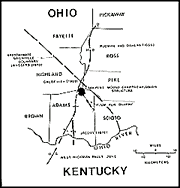
|
|
|
A tectonic map showing the numerous fault lines that converge in and around the area of the Serpent Mound acropolis.
Image from
Serpent Mound Mysteries.
|
|
 Serpent Mound Lies near the Intersection of Several Fault Lines:
Serpent Mound Lies near the Intersection of Several Fault Lines:
The Serpent Mound acropolis is situated in a somewhat unstable tectonic area, the features of which are related to the cryptoexplosion event that elevated the Serpent Mound plateau to its current level. This region has been subject to occasional minor earthquakes, but none of any significance have occurred in recorded history.
 Serpent Mound Lies in an Area of Unusual Magnetic Activity:
Serpent Mound Lies in an Area of Unusual Magnetic Activity:
The Serpent Mound acropolis sits on the most intense magnetic anomaly in the state of Ohio. This may be caused by substantial iron ore deposits that were pushed up by the cryptoexplosive event, iron ore deposits in the nearby Brush Creek, the existence of a 3-ton solid steel observation tower on the south side of the site, or perhaps a combination of all three.
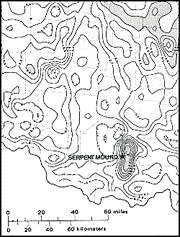
|
|
|
A radiometric map showing relative surface concentrations of uranium ore in the surface soils of the Serpent Mound area. The heavily
shaded areas show high concentrations of uranium, which may account for the gravitic anomalies found there.
Image from
Serpent Mound Mysteries.
|
|
 Serpent Mound Lies in an Area of Gravitic Anomalies:
Serpent Mound Lies in an Area of Gravitic Anomalies:
The Serpent Mound acropolis presides over an area of unusually intense gravitic anomalies, most likely due to the presence of the aforementioned magnetic anomalies, as well as the presence of relatively high concentrations of uranium ore near the surface.
 Serpent Mound Lies Near the Juncture of Three Major Streams:
Serpent Mound Lies Near the Juncture of Three Major Streams:
The Serpent Mound acropolis is also surrounded by significant water resources, including Ohio Brush Creek, Baker Fork, and Middle Fork, all three of which converge nearby. Interestingly, running water is thought by some to be at least partially responsible for some of the phenomena to found around
Silbury Hill
in southern England.
 Serpent Mound Lies Near the Border of Three Major Soil Types:
Serpent Mound Lies Near the Border of Three Major Soil Types:
The Serpent Mound acropolis is made up of shallow, stony and acidic soil, whereas the soil just to the west of the ridge is made up of loam and flood-deposited sediments, and one-half mile south of the mound the soil is made up of 10-20 inches of wind-deposited loess. The thin, acidic soil is conducive of cave formation, which some believe may honeycomb the plateau.1
As a result of the numerous faults running through the substrata, the acidic content of the soil, and the predominance of rainfall in the region, the Serpent Mound acropolis is also rife with caves. Running along the fault lines and other fragments caused by the cryptoexplosive event, these caves, caused by rainfall made acidic by leaching through the thin, rocky, acidic soil over long periods of time, may form a warren of underground passages underneath the serpent. These passages were likely once inhabited by those who had made the serpent. If so, then a treasure trove of artifacts may await archaeologists brave enough to search out the unknown country that may lie beneath their feet.


|
|
|
A closer view of the Serpent Mound acropolis from the steel observation tower just southeast of the mound. The tail is on the left side of the image, and the partly visible head is located near the top right of the image. Click
here
to see a larger version.
Image © 2002 Mysterious World.
|
|
Driving through southern Ohio is a pleasant journey to a simpler time. Searching for Serpent Mound, for those who have the time and the patience, is nearly as interesting an experience as discovering the mound itself. A leisurely drive through small town and tilled field serves as good preparation for the simple beauty of the mound, and of the simpler lifeways that it represents.
Only a few hours of driving from
Cincinatti
or
Dayton,
the search for the mound merely requires patience and a good map. Calmly navigating the rolling hills of the southwestern Ohio farmlands, one can see why our ancient predecessors on this American continent chose this land as their home. As the drive starts to climb in elevation, the searcher begins to feel the immanent power and simple beauty emanating from the symmetry of farm and field
surrounding the Serpent Mound acropolis.
 Lost in a pastoral daydream, the seeker must remain aware lest he miss the subtly placed entrance to the mound off of the small rural highway that insinuates itself around the ancient outcropping whereon the serpent resides. Once found, the wide entryway narrows to a slender driveway that slithers
luxuriously up a modest incline, concluding in a small parking lot and picnic area at the top of the bluffs. This is the
Serpent Mound State Memorial.
Lost in a pastoral daydream, the seeker must remain aware lest he miss the subtly placed entrance to the mound off of the small rural highway that insinuates itself around the ancient outcropping whereon the serpent resides. Once found, the wide entryway narrows to a slender driveway that slithers
luxuriously up a modest incline, concluding in a small parking lot and picnic area at the top of the bluffs. This is the
Serpent Mound State Memorial.
The park that separates the mound from the outside world is a broad expanse of Ohio Bluegrass freckled with a variety of trees and modest park facilities, ideal for a family outing. Walking down the comfortably paved walkway toward the
|
|
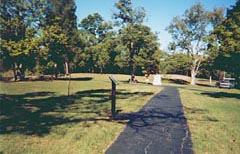
|
|
|
The pathway to the Serpent Mound.
Image © 2002 Mysterious World.
|
|
mound, the adventurer passes a neatly organized small museum/tourist center, and is soon met with a sign and a memorial that describe the history of the mound. The small park area then quickly gives way to the wide open space of the mound itself, a long avenue of meandering green surrounded by trees on three sides.
Whereas the park area is ideal for a family outing, the mound itself seems more suited for solitary contemplation. The seeker first approaches the serpent from the tail section, which uncoils mysteriously from a near-perfect spiral to the undulations of a crawling serpent, terminating in a head that is over 1,200 feet away. A cleverly planned trail takes the visitor around the whole of the serpent mound, as well as giving access to special details of the mound, such as the finely wrought spiral of the serpent's tail and the mysterious oval mound in front of the head of the serpent.
|
|
|
|
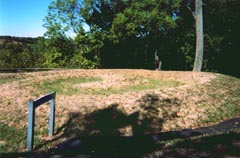
|
|
|
Serpent Mound tail detail.
Image © 2002 Mysterious World.
|
The whole layout of the serpent, from the head to the tail, was reproduced by our ancient forebears in precise detail, with a flair for
artistry that is still impressive even today. The coils of the serpent, three in number, seem to be sized and spaced precisely, as if part of a predetermined pattern. The head also seems oddly small,
and appears in profile with its mouth open,
as if the viewer were meant to understand that the serpent was opening its mouth in order to swallow the oval mound in front of it. Others, however, see different symbolism behind the great orb at the head of the serpent, so exactly what the serpent and the mysterious orb represented in the mythology of the ancient Ohioans is still up for debate. Whether it was an object of worship, a ritual space, an astronomical calendar, or a combination of these and other uses, the Great Serpent Mound remains a popular source of study and speculation.



Make sure to return next quarter for part II of our series on Serpent Mound to learn more about the place of Serpent Mound in the history, myth and ritual of ancient Ohio.

|
|
|
The Serpent Mound as one first sees it from the south. To the left is the trail that leads to the serpent's tail, which then loops around the entire mound and back again to the observation tower on the right. Click
here
to see a larger version.
Image © 2002 Mysterious World.
|
|

Visit the serpent in its natural habitat and feel the magic for yourself.
Serpent Mound State Memorial
is
located
10 miles north of the town of
Peebles
in
Adams County,
Ohio. Serpent Mound is off State Route 73, six miles north of State Route 32 and 20 miles south of Bainbridge. The park is open year-round 10 a.m.- 5 p.m., except for Thanksgiving, Christmas and New Year's Day. There is a parking fee of $6 per car, $2 per motorcycle, $8 per RV and commercial van, $30 per school bus, and $60 per commercial bus, but parking is free for
OHS members. For more information, contact
Serpent Mound
at the following address:
Serpent Mound, 3850 State Route 73, Peebles, OH 45660; phone: 937-587-2796; toll free: 1-800-752-2757; email: serpent@bright.net; website: http://www.ohiohistory.org/places/serpent/. 
Serpent Mound Part II: Sacred Serpent
The Domain of the Serpent
|
The Lair of the Serpent
|
Visiting the Serpent
Serpent Mound Links
|
Serpent Mound Books
|
Serpent Mound Audio
Editorial
|
Press Releases
|
Book Reviews
|
Fragments
Serpent Mound I
|
Giants I
|
Osiria I
Register
for our new Hall of Records Newsletter!
Questions? Comments? Suggestions? Advertising? Press Releases?
Contact us!

1
Bulleted points condensed from William F. Romain,
"Terrestrial Observations at the Serpent Mound"
Serpent Mound Mysteries (http://greatserpentmound.org)


 Effigy Mounds: Roadmap
Effigy Mounds: Roadmap
 MNSU eMuseum: Serpent Mound
MNSU eMuseum: Serpent Mound
 Serpent Mound State Memorial
Serpent Mound State Memorial
 Artcom Museums Tour: Serpent Mound State Memorial
Artcom Museums Tour: Serpent Mound State Memorial

 The Ohio Historical Society: Serpent Mound
The Ohio Historical Society: Serpent Mound
 The Archaeological Society of Ohio: Serpent Mound
The Archaeological Society of Ohio: Serpent Mound
 Archaeology Magazine: "Redating Serpent Mound"
Archaeology Magazine: "Redating Serpent Mound"
 Don Wesley: The Serpent Mound
Don Wesley: The Serpent Mound
 The Metropolitan Museum of Art: Great Serpent Mound
The Metropolitan Museum of Art: Great Serpent Mound
 Ohio History Central: Serpent Mound
Ohio History Central: Serpent Mound
 National Trust: Prehistoric Serpent Mound
National Trust: Prehistoric Serpent Mound
 Adams County History: Serpent Mound
Adams County History: Serpent Mound
 World Crater Inventory: Serpent Mound
World Crater Inventory: Serpent Mound
 NativeNet: Serpent Mound in Danger?
NativeNet: Serpent Mound in Danger?
 California State University: Great Serpent Mound
California State University: Great Serpent Mound
 El Camino College Online: The Great Serpent Mound
El Camino College Online: The Great Serpent Mound
 The Comparative Archaeology Web: "The Late Woodland Cultures of Woodland Period in the Woodland Culture Area of the Eastern US"
The Comparative Archaeology Web: "The Late Woodland Cultures of Woodland Period in the Woodland Culture Area of the Eastern US"
 Search for the Hopewell Road: "The Ancient Ohio Valley"
Search for the Hopewell Road: "The Ancient Ohio Valley"
 RootsWeb: Moundbuilders
RootsWeb: Moundbuilders
 RootsWeb: Adams County Geneology
RootsWeb: Adams County Geneology
 UMKC: Ohio Facts
UMKC: Ohio Facts
 National Register of Historic Places
National Register of Historic Places

 Serpent Mound Mysteries
Serpent Mound Mysteries
 Serpent Mound Mysteries: Terrestrial Observations at the Serpent Mound
Serpent Mound Mysteries: Terrestrial Observations at the Serpent Mound
 Serpent Mound Mysteries: "A Tradition of Giants"
Serpent Mound Mysteries: "A Tradition of Giants"
 Outside Ashland: The Great Serpent Mound
Outside Ashland: The Great Serpent Mound
 FarShores: "Ohio's Ancient Serpent Mound Link To Summer Solstice?"
FarShores: "Ohio's Ancient Serpent Mound Link To Summer Solstice?"
 Dowsing for Ancient Alignments: Serpent Mound
Dowsing for Ancient Alignments: Serpent Mound
 Forgotten Ohio: Adams County: Serpent Mound
Forgotten Ohio: Adams County: Serpent Mound
 Cincinnati.com Travel: A Mystery Lost to Time
Cincinnati.com Travel: A Mystery Lost to Time
 Southeast Ohio Magazine: "Mounds, Mystery & History"
Southeast Ohio Magazine: "Mounds, Mystery & History"

 OhioTourism.com: Serpent Mound
OhioTourism.com: Serpent Mound
 OhioTourism.com: Free Publications
OhioTourism.com: Free Publications
 OhioTourism.com: Map of Ohio (PDF)
OhioTourism.com: Map of Ohio (PDF)
 OhioTourism.com: Places to See in Southwest Ohio (PDF)
OhioTourism.com: Places to See in Southwest Ohio (PDF)
 Wildernet Trip Planner: Ohio
Wildernet Trip Planner: Ohio
 Adams County, OH Chamber of Commerce
Adams County, OH Chamber of Commerce
 Peebles, Ohio info
Peebles, Ohio info
 Adams County Travel and Visitors Bureau
Adams County Travel and Visitors Bureau
 Adams County Travel and Visitors Bureau: Lodging
Adams County Travel and Visitors Bureau: Lodging
 Adams County Travel and Visitors Bureau: Serpent Mound in the Winter
Adams County Travel and Visitors Bureau: Serpent Mound in the Winter
 Ohio History Travelogues: Great Serpent Mound
Ohio History Travelogues: Great Serpent Mound
 Places Ohio: Serpent Mound
Places Ohio: Serpent Mound
 CityBeat: Slinking to Serpent Mound
CityBeat: Slinking to Serpent Mound
 UHAUL SuperGraphics: Ohio Serpent Mound
UHAUL SuperGraphics: Ohio Serpent Mound
 Online Highways: Serpent Mound
Online Highways: Serpent Mound
 CitySearch: "Serpent Mound Memorial Park"
CitySearch: "Serpent Mound Memorial Park"
 Youngstown State University: Ohio Mounds Tour
Youngstown State University: Ohio Mounds Tour
 Lisa's Travel Journal and Photos: Southern Ohio mounds
Lisa's Travel Journal and Photos: Southern Ohio mounds
 Lisa's Travel Journal and Photos: Serpent Mound video
Lisa's Travel Journal and Photos: Serpent Mound video
 Corn and Ancient Effigy Mounds in Ohio
Corn and Ancient Effigy Mounds in Ohio
 OPLIN: Discover Ohio: Adams County Links
OPLIN: Discover Ohio: Adams County Links
 Cincinatti.com: Travel
Cincinatti.com: Travel
 VirtualTourist.com: Dayton, Ohio
VirtualTourist.com: Dayton, Ohio


 Indian Mounds of the Middle Ohio Valley: A Guide to Mounds and Earthworks of the Adena, Hopewell, Cole, and Fort Ancient People
Indian Mounds of the Middle Ohio Valley: A Guide to Mounds and Earthworks of the Adena, Hopewell, Cole, and Fort Ancient People
Susan L. Woodward, Jerry N. McDonald
Rating:




Throughout history, the mound-builder societies of the many Native American cultures have captured many people's attention. The indigenous mound-building society in Wisconsin, known as the Ho-Chunk, or Winnebago, and the Ioway people were two of the most prolific in the U.S. Because of the increased requests for information, Birmingham and Eisenberg have completed one of the most comprehensive guides to the mounds of Wisconsin. Previously, none of the information on the mounds or their builders was available in a complete volume. Beginning with Wisconsin's early occupants, this work details 2,000 years of history, from pre-mound-builder groups to the modern era. Throughout the book, there are photographs, maps, and detailed drawings of artifacts, people, and the mounds. Included in the appendix is a listing of mound sites open to the public. Indian Mounds is an important and necessary addition to any collection on Native American cultures and the early history of the Midwest. (Review by Amazon.com)
Click
here
to buy this book.
 Serpent Mound Adams County, Ohio 1907
Serpent Mound Adams County, Ohio 1907
E. O. Randall
Rating:



Mystery of the mound and history of the serpent, containing various theories of the effigy mounds and the mound builders. The author states this monograph is not a scientific treatise on the serpent mound, but rather an attempt to present in popular form all that is worthy of publication concerning Ohio's most unique prehistoric relic, the origin and purpose of which is still a mystery. (From the book description)
Click
here
to buy this book.
 The Mound Builders
The Mound Builders
Robert Silverberg
Rating:





"Our forebears, finding large, incomprehensible earthworks scattered down the Mississippi Valley, refused to believe they were built by the aborigines who still cluttered up the place and impeded settlement. Mr. Silverberg describes, with gleeful and copious quotation, the nineteenth-century literature of speculation which attributed these monuments to Phoenicians, stray Vikings, the lost tribes of Israel, refugees from Atlantis, an extinct race of giants, and Welshmen. The book, which is charmingly written, ends with a history of the archaeological work which gave the mounds back to the Indians." (Review by The Atlantic Monthly)
Click
here
to buy this book.
 Ancient Monuments of the Mississippi Valley (Classics in Smithsonian Anthropology)
Ancient Monuments of the Mississippi Valley (Classics in Smithsonian Anthropology)
Edwin H. Davis, David J. Meltzer (Editor), Ephraim G. Squier
Rating:





Ancient Monuments (more familiarly known as "Squire and Davis") is the undisputed primary reference source on Indian mounds in the eastern US till the mid-1800s. While there were a few others (such as Caleb Atwater's book), Squire and Davis offers the grandest illustrations of what remained of the unbelievable civilizations that inhabited this continent. Even as they published in 1848, hundreds of mounds were being plowed into oblivion; so few are still extant that theirs is the only guide to what was lost. The text is enjoyable on many levels, and can be forgiven for any lapses of scientific accuracy. They trekked over Ohio at a time when we weren't even sure who made the mounds, so everything they recorded is gold. The engineering prowess, the sheer magnificence and scale of some of the works, is astounding. (Review by Amazon.com)
Click
here
to buy this book.
 Mysteries of the Hopewell: Astronomers, Geometers, and Magicians of the Eastern Woodlands (Ohio History and Culture)
Mysteries of the Hopewell: Astronomers, Geometers, and Magicians of the Eastern Woodlands (Ohio History and Culture)
William F. Romain
Rating:





Buried beneath today's Midwestern towns, under several layers of earth and the accumulated debris of two thousand years, are the clues to an ancient mystery. A Native American people, now known as the Hopewell, lived and worked these lands, building earthworks which in some instances dwarf the ruins at Stonehenge. More significantly, these mammoth earthworks were built in different geometric shapes, using a standard unit of measure and aligned to the cycles of the sun and the moon.
Using the foundation of existing scholarship, Mysteries of the Hopewell presents new discoveries showing the accomplishments of the Mound Builders in astronomy, geometry, measurement, and counting. William Romain then goes one step further to theorize why generations of people toiled to move millions of tons of earth to form these precise structures, joining the ranks of the Egyptians, Mayans, Greeks, Chinese, and other advanced ancient cultures. (From the book description)
Click
here
to buy this book.
Mound Builders of Ancient America: The Archaeology of a Myth
Robert Silverberg
Click
here
to buy this book.
 The Eagle's Voice: Tales Told by Indian Effigy Mounds
The Eagle's Voice: Tales Told by Indian Effigy Mounds
Gary J. Maier
Gary Maier's The Eagle's Voice: Tales Told By Indian Effigy Mounds is a kind of anthropological detective story based on Maier's research involving a group of about fifty Indian effigy and conical mounts located on the north shore of Lake Mendota, in Madison, Wisconsin. In his explorations Maier developed a new understanding and insight into these structures which had fascinated and puzzled Europeans and Americans from the 1830s down to the present day. Exceptionally "reader friendly", The Eagle's Voice is enthusiastically recommended reading for the non-specialist general reader with an interest in Native American culture in general, and the effigy mounds of Wisconsin in particular. (Review by Amazon.com)
Click
here
to buy this book.
Under Your Feet: The Story of the American Mound Builders
Blanche King
Through archaeological examinations of the mounds of the Mississippi River Valley, Blanche Busey King reconstructs the lives of the prehistoric inhabitants of that region who built these mounds. Chapters are dedicated to the various objects discovered in the mounds, including clothing, fetishes, flints, copper and bone implements, and many of the artifacts are illustrated by photographs included in the text. King also briefly compares the American Mound Builders to the prehistoric inhabitants of Europe.
Click
here
to buy this book.
The Effigy Mound Culture of Wisconsin
Chandler W. Rowe
Click
here
to buy this book.
Effigy Mounds: Monuments of the Earth
Ellen Osterhaus
Click
here
to buy this book.
 The American Woodland Indians
The American Woodland Indians
Michael G. Johnson, Richard Hook (Illustrator)
The Woodland cultural areas of the eastern half of America has been the most important in shaping its history.
This volume details the history, culture and conflicts of the 'Woodland' Indians, a name assigned to all the
tribes living east of the Mississippi River between the Gulf of Mexico and James Bay, including the Siouans,
Iroquians, and Algonkians. In at least three major battles between Indian and Euro-American military forces
more soldiers were killed than at the battle of Little Bighorn in 1876, when George Custer lost his command.
With the aid of numerous illustrations and photographs, including eight full page colour plates by Richard Hook,
this title explores the history and culture of the American Woodland Indians.
Click
here
to buy this book.

 Serpent Mound
Serpent Mound
Rusty Crutcher
Rating:
   
Evocative music and traditional chants evoke the powerful mystery of the Great Serpent Mound, the first century BC, quarter-mile long Native American animal effigy in southern Ohio. Piano, keyboard, Lakota flute, ocarina and exotic hand percussion subtle blend with on-site environmental recordings. Chants by Jaccarilla Apache Matthew Andrae honor this oldest and largest surviving raised-earth mound in North America. (Review by Amazon.com)
Click
here
to buy this CD.
Editorial
|
Press Releases
|
Book Reviews
|
Fragments
Serpent Mound I
|
Giants I
|
Osiria I
Register
for our new Hall of Records Newsletter!
Questions? Comments? Suggestions? Advertising? Press Releases?
Contact us!
|

